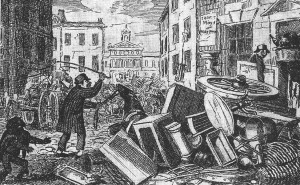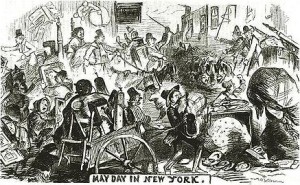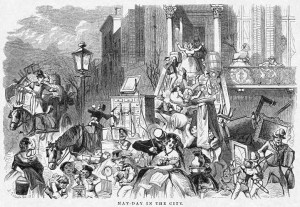As many genealogical researchers know, tracing your ancestors in major metropolitan areas can prove difficult, thanks to the use of similar names, confusing address patterns, and, often, changing locations. In New York City, residents changed addresses rather frequently, making it challenging to place them in any one location for an extended period. Interestingly, residents in New York City often relocated around the same time each year due to a long-standing tradition, Moving Day.
Moving Day was a tradition in New York City that began in colonial times and continued up through the end of World War II. Every year, landlords would give their tenants notice of the new rent prices for the following quarter on 1 February, also known as Rent Day. City residents who intended to move would spend the spring days with good weather searching the city for a new home.[1] On 1 May, all leases in the city expired, so all residents then moved to their new homes at the same time, creating chaos in the streets.[2]
In the late eighteenth century, and throughout much of the nineteenth century, many farmers from Long Island and New Jersey came into the city on 1 May and offered the use of their carts for a fee to aid the moving city dwellers.[3] According to the account of one nineteenth century cartman, Isaac S. Lyon:
During the last two weeks in April of each year the cartmen begin to put on a few extra airs, and look and act with the more importance than at any other time during the year. Everybody then calls him Mr. Cartman, and when the first of May arrives then ‘stand from under!’ He then becomes very domineering, and everybody feels that it is their interest, if not their duty, to bow and cringe to him, for on that day of all the year it is generally admitted that a cartman may charge any price that he pleases.[4]
Often, the relocation of tenants was not a matter of choice, but of necessity, as historian Edwin G. Burrows notes: “in a tight, impersonal, and utterly unregulated housing market, where landlords pressed to maximize rent, tenants outbid by competitive renters were compelled to move.”[5] Citizens were not only faced with increasing rents intended to drive them out of their homes, but also with the high rates charged by the cartmen, causing some individuals to spend as much as a week’s wages for the right to utilize a moving cart.[6] While the city often set the rates which the cartmen were permitted to charge, these regulations were sometimes ignored. If payment was not received at the time of the delivery of the customer's possessions, the cart operator had the right to bring the load directly to the police station and to charge an extra fee for this delivery.[7]
While many families still relocated on 1 May, as early as 1856 some landlords became more relaxed in their policies, allowing tenants to move in a few days early or late, creating more of a ‘moving week.’[8] By the time the Depression of 1873 ended in the spring of 1879, more housing was being constructed and prices began to drop, leading to a decreased need for families to relocate on a yearly basis.[9]
Another element of the changing culture of New York City which affected the Moving Day tradition was the suburban relocation of many residents in the summer months. In many cases, residents of New York City would remove to cooler suburbs of the city during the hottest months of the year, returning to newly rented homes at the end of the season, and, as a result, 1 October became the new de facto Moving Day for many city dwellers.[10] Despite these changes, it was estimated that in the early twentieth century as many as one million residents changed residences at the same time. While there was a resistance to the annual tradition in the 1920s and 1930s, it was not until the beginning of World War II, when able-bodied men who could be used as movers were in short supply, that the practice came to an end.[11]
While the tradition of Moving Day is all but a distant memory to most New Yorkers, it was an important yearly event which played a significant role in how researchers trace their ancestors who lived in the city before World War II.
Notes
[1] “Facetious Landlords,” New York Times, 13 February 1854, http://query.nytimes.com/mem/archive-free/pdf?_r=1&res=9A0CEFDD103AE334BC4B52DFB466838F649FDE.
[2] “May Day. A History of ‘Moving Day’: Its Pleasures in the Past and Miseries in the Present,” New York Times, 30 April 1873, http://query.nytimes.com/mem/archive-free/pdf?res=9505E7D7163DE43BBC4850DFB2668388669FDE.
[3] “Letter,” New York Times, 2 May 1856, http://www.baruch.cuny.edu/library/alumni/online_exhibits/digital/2007/moving_day/images/007_lg.gif.
[4] Isaac S. Lyon, Recollections of An Old Cartman [Old New York Street Life], introduction by Graham Hodges (New York, 1984), p. 4, http://www.baruch.cuny.edu/library/alumni/online_exhibits/digital/2007/moving_day/page003.html.
[5] Edwin G. Burrows, Gotham: A History of New York City of 1898 (New York: Oxford University Press, 1998), p. 392.
[6] Alexsandr Gelfand, CUNY, “Moving Day Exhibit,” http://www.baruch.cuny.edu/library/alumni/online_exhibits/digital/2007/moving_day/images/015_lg.gif.
[7] “What it Costs to Move,” New York Times, 29 April 1890, p. 5, http://www.baruch.cuny.edu/library/alumni/online_exhibits/digital/2007/moving_day/images/015_lg.gif.
[8] “First of May-Moving Day,” New York Times, 1 May 1855, http://query.nytimes.com/mem/archive-free/pdf?res=950DE7DF103DE034BC4953DFB366838E649FDE.
[9] “Moving Day” in Encyclopedia of New York City, edited by Kenneth T. Jackson (New Haven, Conn.: Yale University Press, 1991).
[10] Gelfand, “Moving Day Exhibit,” http://www.baruch.cuny.edu/library/alumni/online_exhibits/digital/2007/moving_day/page001.html.
[11] Ibid.
Share this:
About Zachary Garceau
Zachary J. Garceau is a former researcher at the New England Historic Genealogical Society. He joined the research staff after receiving a Master's degree in Historical Studies with a concentration in Public History from the University of Maryland-Baltimore County and a B.A. in history from the University of Rhode Island. He was a member of the Research Services team from 2014 to 2018, and now works as a technical writer. Zachary also works as a freelance writer, specializing in Rhode Island history, sports history, and French Canadian genealogy.View all posts by Zachary Garceau →


